Index


Review: CoolIT ECO Advanced Liquid Cooling
ECO A.L.C., which is our today’s guest, is an all-in-one water cooling system for the CPU that’s quite simple to mount and use. Many users dread the mere notion of having water within their computers, but ECO A.L.C. will quickly make them forget fear and complication often associated with pouring water and mounting fluid carrying pipes to the water blocks and radiator(s). This time around however, simplicity is the key and what you see on the picture below is basically all you’ll need.

ECO A.L.C. (Advanced Liquid Cooling) is a product coming from CoolIT systems. It’s well worth noting that CoolIT is capable of performing all stages in making a product – meaning both R&D and manufacturing, which makes designing and producing quality cooling solutions much, much easier. The same goes for company-customer relations, making feedback-requested changes to products a far less complicated task, which can’t be said for many companies out there.
ECO A.L.C. box is small but tough and packs a lot of info. Everything you’d like to know is on the sides of the box, down to the details.

Upper left corner features CoolIT’s award which the company received on CES for its new designs and innovation.



The box measures 22.5 x 15 x 18.5cm, which is smaller than most cooling packages. Still, as you can see the ECO A.L.C. is pretty safe within the box.

Within the box you’ll find everything you need: ECO A.L.C. preconfigured for mounting on Intel’s processors, a backplate for socket 1366, backplate for socket 1156, backplate for socket 775, 2x bracket for AMD processors, 4x screws for the case (and mounting ECO’s fan/radiator) and an installation manual that fit onto an A4 page, which says enough on just how simple it is to mount this device.

Official Specification: ECO A.L.C.
CoolIT CPU FHE (Fluid Heat Exchanger)
Copper Micro-Channel
Universal Retention System
Out of the box support provided
for Intel 775, 1156, 1366 and
AMD AM2, AM2+, AM3 sockets.
CoolIT Proprietary Pump
Quiet, compact, long life CFF1 pump
Ceramic bearing
Life Cycle: 50,000 Hours MTTF
CoolIT Coolant
CoolIT Systems low toxicity with anticorrosion/
anti fungal additives
CoolIT Radiator
Custom engineered for low noise high heat dissipation
CoolIT Fan
High reliability, Quiet 12V
Speed: 1800 RPM MAX
CoolIT CPU Thermal Grease
CoolIT Systems Pro A.T.C.
(Advanced Thermal Compound)
CoolIT 2 Year Manufacturer Warranty
CoolIT made ECO A.L.C. with a specific aim of defeating high-performance air coolers both in performance and pricing. ECO A.L.C. is priced at $72.86 here and at €74,90 here. It doesn’t take a rocket scientist to realize that ECO A.L.C. is superior to classic water cooling systems especially to average users. It’s priced lower, it’s smaller and comes as a preinstalled system with no need for adding fluids yourself – mount it and you’re good to go. On the other hand, users who prefer more customizable systems will probably find these benefits to be shortcomings, as classic water cooling systems allow for replacing or adding water blocks, mounting longer pipes and/or new radiators and such. ECO A.L.C. is made of three components that are sealed shut and can’t be removed or replaced without voiding the warranty; there’s the radiator, water pumps and the adjoining pipes. CoolIT made sure everything is locked and loaded so all you need to do is mount the cooling.

The radiator with the accompanying fan should be mounted on the back panel of the case, where 12cm fans are usually mounted. The radiator is about 2 cm thick and the fan about 2.5cm. All this was done with compactness in mind as CoolIT wanted to make sure that its cooling system is compatible with smaller cases. Naturally, the smaller the radiator the lower the dissipation surface is and the cooling loses efficiency, but as long as you’re not doing extreme overclocking – ECO A.L.C. will serve you well.

For efficient cooling, CoolIT opted on a combination of a wide-fin fan and a radiator with densely distributed aluminum fins. The company pretty much aimed to fix all the downsides to its last year’s model Domino A.L.C., which was pretty loud. The ECO A.L.C.’s fan should be pretty efficient with low noise fans which produce less airflow but run quiet throughout.
Talking about airflow, the fan draws air through the radiator, cooling the radiator and getting the hot air out in the process.

The fan is connected to the CPU fan spot on the motherboard via a 4-pin connector. Fan speed can be controlled from BIOS of the motherboard or a separate fan controller. Maximum fan speed stands at 1800 rpm.
The water pump also needs power and you’ll connect it to one of the fan connectors on the motherboard, rather than on the CPU fan connector. Coolit CFF1 pump is pretty efficient with power consumption and requires only 1W.

The pump is rated as ultra low profile and is pretty compact. The pump, together with the base, is about 5.1cm tall and it’s well worth noting that no air cooling with similar efficiency can even come close to the compactness of the ECO A.L.C. The pump and the base are pretty light as well and won’t put pressure on your motherboard, unlike some large and pretty heavy air-coolers. As you can see from the picture, CoolIT’s pro advanced thermal compound is pre-applied for easy installation to the copper block but you won’t get more thermal compound with the ECO A.L.C.

Preassembled and preconfigured for Intel’s processors, ECO A.L.C. is pretty easy to mount. The hardest part is mounting the backplate, but this has become a common feature with cooling and we’ve done it numerous times. The mechanism for Intel’s processors is so simple that amateur users will easily mount it on socket 1366, 1156 or 775. As you can see from the following picture, CoolIT indicated the screw placement for specific Intel socket. For mounting on AMD AM2, AM2+ or AM3 socket, you’ll need to replace Intel’s mounting mechanisms with AMD’s.

We must admit that this year’s CooIT favorite makes last year’s Domino A.L.C. a giant in comparison, as ECO A.L.C. is rated as ultra low profile advanced cooling solution and it sure justifies its rating. The “hardest” task you’ll encounter will be if you don’t have a hole in your motherboard tray, in which case you’ll have to remove the motherboard in order to mount the backplate - everything else is a matter of minutes.

The radiator and the fan are easy to mount and although the pipes leading to the pump are pretty short and rigid, they will reach the rear panel of the case. The fan is already mounted so inexperienced users will have their work cut out for them.

CoolIT’s user’s manual says to connect the pump to either three-pin fan connector rather than the four-pin CPU fan connector. On the picture above, you see ECO A.L.C. mounted in Corsair Obsidian 800D case and on EVGA 3xSLI X58 motherboard. The picture below shows the cooling mounted on EVGA 4xSLI Classified. The cable starting on the pump is only 17cm long and in our case this was a problem during mounting. Namely, the cable barely reached the fan connector on our EVGA 4x SLI motherboard.

The fan is mounted to draw air through the radiator and push it out of the case.

Unlike Corsair’s H50, ECO A.L.C. comes with a preinstalled fan which draws air through radiator fins and pushes it outside the case. Corsair on the other hand, recommends a setup where the fan will blow inside the case drawing cool air from the outside, which is perhaps a wiser option if you aim for better CPU cooling, but it can cause higher temperatures within the case. For comparison purposes however, in few tests we mounted Corsair’s H50 cooling so that it performs identically to the ECO A.L.C. i.e. push the air outward.
Radiator and fan size, as well as pump bases, are pretty much the same on ECO A.L.C. and Corsair H50, so testing should go pretty close. CoolIT’s radiator is a few millimeters wider and taller (picture, right), with 13 columns each with 94-95 aluminum fins. In comparison, Corsair’s H50 radiator features 12 columns each with 95-97 fins (we apologize if we missed a couple, feel free to zoom in and prove us wrong).

For our testing, we used Intel’s Core i7 965 XE CPU, both reference clocked and overclocked. This CPU has a 130W TDP and is a great candidate for our test. In the first part of our testing, we subjected our candidates to more extreme torture with power saving options in BIOS turned off, which resulted in a few °C more. In the second part of our testing we turned on Vdrop and EIST.
Idle temperatures were measured after half an hour of idle operation whereas our more demanding tests were performed with a little help of Prime95 blend test. We used Everest Ultimate Edition v5.50 to read CPU temperatures, as well as EVGA’s ECP V2 external control panel that comes with EVGA 4xSLI Classified motherboard.
We performed all tests three times, not only by restarting the rig but rather by taking the pump off, cleaning it and reapplying thermal paste. Ultimately we had to do it this way because of temperature differences during different measurement sessions. This could’ve been caused by thickness or thermal paste or just temperature changes in the room, so we ended up using average values taken from three repeated tests. Both systems (ECO A.L.C. and H50) performed similarly.
Test 1.
The setup:
EVGA 4xSLI Classified
Core i7 965 XE (3.2 GHz / 1.164 Volts)
Core i7 965 XE (3.6 GHz / 1.270 Volts)
Core i7 965 XE (4.0 GHz / 1.352 Volts)
Memory 6GB Corsair Dominator 12800 7-7-7-24
Graphics Card Point of View GTX 470
WD VelociRaptor 300G 10,000RPM
XFX 850W Black Edition PSU
Case: Cooler Master Test Bench (Open Case)
Fan Controler: Kaze Master Ace 5.25"
Gelid’s GX Extreme thermal paste.
Operating System: Win7 64-bit
Room temperature was at about 20°-21°C.
We performed the first test aiming to see how Corsair H50 handles
overclocking, so we didn’t turn on power saving options. We used EVGA 4x
SLI Classified motherboard, which unfortunately wouldn’t fit in out
Corsair Obsidian 800D case, so we performed this part of testing on
CoolerMaster’s open Test-Bench case. We’ll soon show temperatures
measured in Obsidian 800D case where we used EVGA 3x SLI motherboard.
For our air-cooling counterparts we used Cooler Master’s V8 cooler,
which packs eight heatpipes and one fan. It’s well worth noting that
this cooler is extremely quiet at lower RPM and will do some serious
cooling if you push it with the RPM-speed regulator. It’s currently
priced at below €42 here, so it’s currently a pretty nice deal.
In the following two tests, Corsair's fan followed CoolIT's method, i.e. drawing air through the radiator and blow it out of the case. The fan rans at maximum RPM.
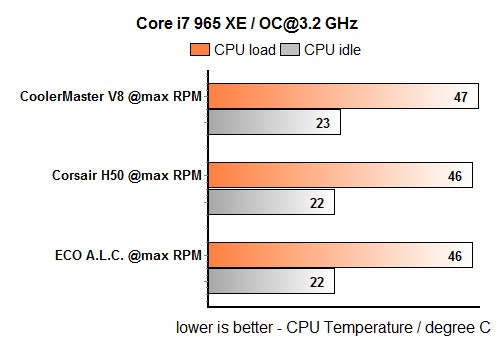
Without overclocking the CPU, performance difference between the ECO and
H50 was pretty much nonexistent, regardless of whether it’s idle
testing or intensive CPU testing. Overclocking the Core i7 965 Extreme
CPU (130W TDP) from 3.2GHz to 3.6GHz led to the first performance lead,
only 1°C, just enough for Corsair to come out on top.
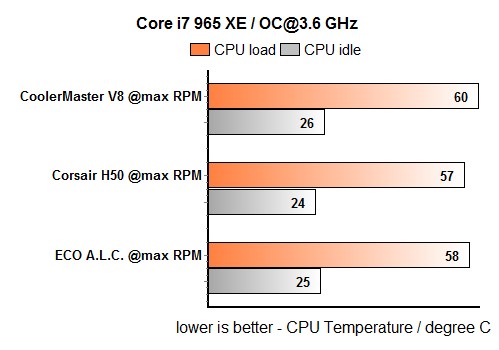
ECO A.L.C. showed that it packs enough juice to perform almost
identically to Corsair H50 during extreme overclocking.
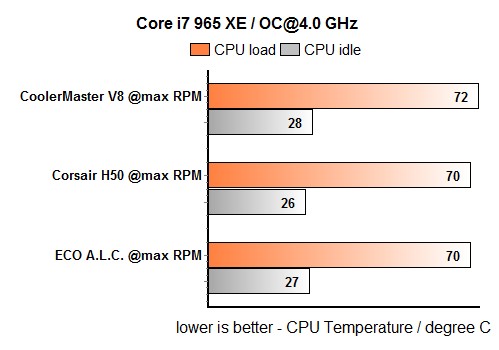
After our testing with CoolIT’s preinstalled fan, we decided to replace the provided fan with Scythe’s S-Flex SFF21G which is capable of airflow at 75.9CFM at 1900RPM. The new fan improved the performance by lowering the temperature by about 2°C during operation, but it ran much louder than CoolIT’s solution.

Test 2.
The setup:
EVGA 4xSLI Classified
Core i7 965 XE (3.2 GHz / 1.164 Volts, Intel EIST and Vdrop enabled)
Core i7 965 XE (3.6 GHz / 1.270 Volts, Intel EIST and Vdrop enabled)
Core i7 965 XE (4.0 GHz / 1.352 Volts, Intel EIST and Vdrop enabled)
Memory 6GB Corsair Dominator 12800 7-7-7-24
Graphics Card Point of View GTX 470
WD VelociRaptor 300G 10,000RPM
XFX 850W Black Edition PSU
Case: Cooler Master Test Bench (Open Case)
Fan Controler: Kaze Master Ace 5.25"
Gelid’s GX Extreme thermal paste.
Operating System: Win7 64-bit
Room temperature was at about 20°-21°C.
In this phase of testing we turned on Vdrop and EIST in our motherboard’s BIOS. This resulted in drastically lower temperatures compared to the previous tests – as much as 11°C lower. We mounted Corsair’s fan to mimic ECO A.L.C., i.e. push the air outwards.
Instead of Cooler Master’s V8 we used our freshly arrived Prolimatech Armageddon, which is a large 144 x 50 x 160.3mm cooler intended for 14cm fans. Prolimatech Armageddon is priced at 59.90 without the fan, but we quickly strapped it with Cooler Master’s A14025-10CB-3BN-F1 14cm fan. You can find out more on Prolimatech Armageddon on Caseking site here.
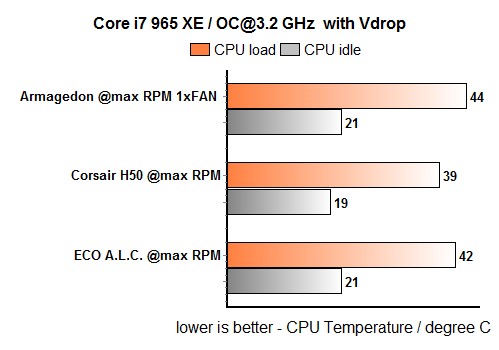
As you can see, Corsair H50 fares pretty well in this test, but it might be due to the fact that the testing was performed on an open test-bench case. In order to be sure that the “old” H50 indeed can beat the recently announced CoolIT ECO A.L.C. system, we did our tests in a closed case as well.
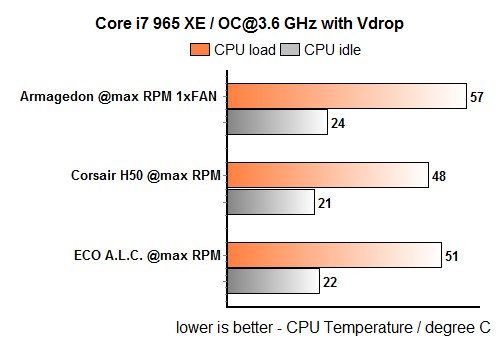
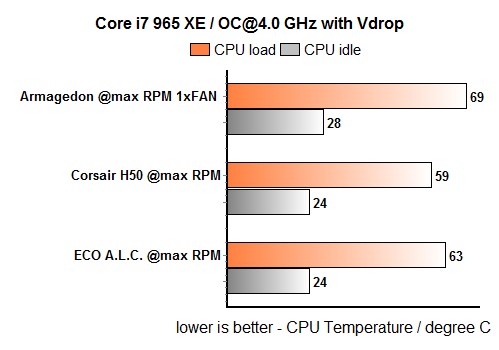
Test 3.
The third test shows temperatures we measured with our two cooling solutions within Obsidian’s 800D case. We tried both fan positions (blowing inward and outward) and even swapped the fans, which ran at maximum speed throughout our tests.
The setup:
EVGA 4xSLI Classified
Core i7 965 XE (3.6 GHz / 1.270 Volts, Intel EIST and Vdrop enabled)
Memory 6GB Corsair Dominator 12800 7-7-7-24
Sapphire HD 5830 (Modern Warfare 2)
WD VelociRaptor 300G 10,000RPM
XFX 850W Black Edition PSU
Obsidian 800D case
Fan Controler: Kaze Master Pro 5.25"
Gelid’s GX Extreme thermal paste.
Operating System: Win7 64-bit
Room temperature was at about 20°-21°C.
As you can see, the results are pretty evened out. We first show results with fans blowing air out of the case (ECO A.L.C.’s default) and then the results with fans blowing inwards.
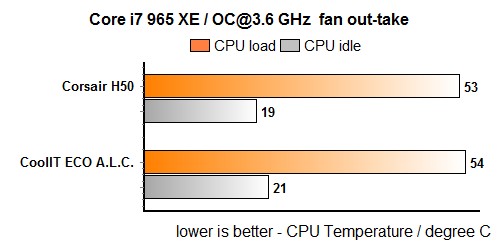
The following table shows that CPU cooling is better if the fan blows through the radiator and into the case, but it does raise overall temperature within the case.
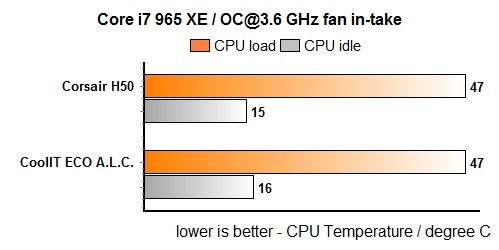
We measured temperatures by using Scythe’s Kaze Master Pro with 6 thermal sensors scattered around the case. One of the sensors was placed on the upper part of the case’s rear panel and it reports higher temperatures when the fan blows inwards, meaning that overall temperature within the case has risen. This thermal sensor recorded about 21°C when the fan blew outwards and about 28°C when the fan blew inward.
Obsidian 800D comes by default comes with no fans on the upper panel. Here you see it strapped with two Scythe S-FLEX SFF21G fans.
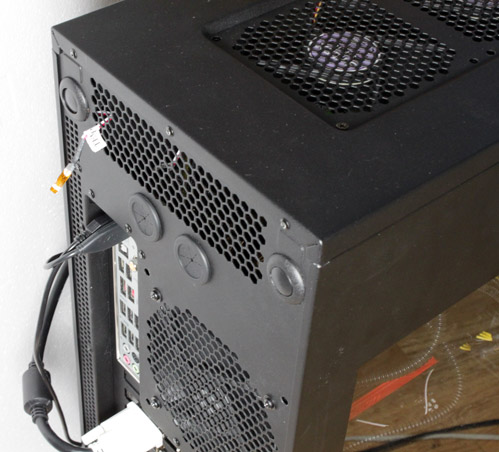
The following picture shows temperatures we measured on our second measuring position. We recorded about 27°C (fan blowing outward) and 33°C (fan blowing inward). The fourth and sixth thermal sensors showed no change in temperatures. Obsidian 800D’s bottom-panel fans push air upwards, and the fans on the top panel expel it out of the case.
We measured the same temperatures with Corsair’s H50 and ECO A.L.C.
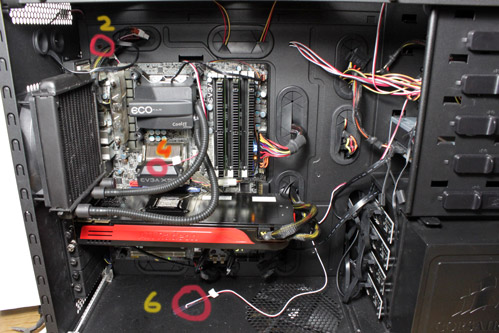
Now we move on to more interesting tests which show that Corsair’s H50 runs better with CoolIT ECO A.L.C.’s fan, and it’s worth noting that ECO A.L.C.’s performance drops with Corsair H50’s fan. We performed these tests with fans blowing out of the case, which we deem better overall.
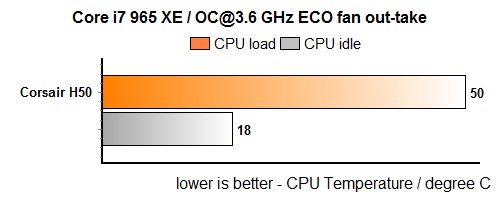
By using ECO’s fan, Corsair H50 performed up to 3°C cooler than with its own fan.
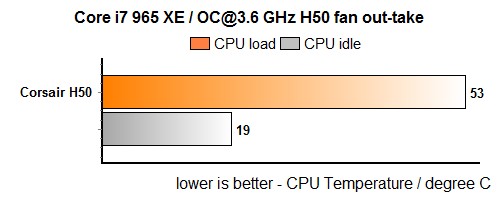
The following two tables show that ECO A.L.C. wasn’t very lucky with H50’s fan and temperatures rose by about 4°C. It appears that Corsair’s fan spins at 1650 RPM in our tests, although it should run at about 1700 RPM. ECO A.L.C.’s fan ran at about 1800 RPM.
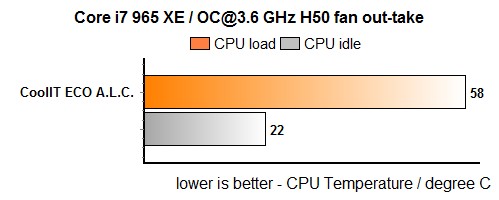

Copper base plate:






Noise
ECO A.L.C. fan is very quiet in idle and although it can well be heard
during the test, it’s in no way too loud. The results you see in the
tables above have been measured at maximum RPM in idle and during
testing. Maximum fan speed is 1800RPM and it runs silent at about
1050RPM. Of course, silence is golden so we advise you to use PWM and
Smart Fan feature with your ECO A.L.C. Performance is good with CoolIT’s
preinstalled fan so you won’t need to change it. The pump is also quiet
during operation and will be pretty much inaudible.
Conclusion
CoolIT ECO A.L.C. is an appealing product to those in the market for a high-end CPU cooler. It’s priced at about €70-80, which means it’s priced similarly to the large air coolers despite the fact that ECO A.L.C. is a water cooling system. One of the advantages of ECO A.L.C. system is that it’s significantly smaller and can be used in much smaller cases, where larger air-cooling solutions might not fit.
ECO A.L.C. will directly compete with Corsair H50, which is based on the same principle and is priced similarly. Our testing revealed that both systems perform similarly as well, and both solutions took 3.6GHz and 4GHz overclocks in stride. Our test CPU, Core i7 965 XE CPU has a 130W TDP, meaning that users with a similar or slower CPU will be more than covered with ECO A.L.C. (Advanced Liquid Cooling) system.
As far as ease of mounting goes, ECO is up there with most simplest of systems and the only thing that might take more time is mounting the backplate. The radiator and the accompanying fan is mounted on the rear panel of the case and the small pump with a large copper base is placed on the CPU. The adjoining pipes are sealed shut and the liquid has already been poured, meaning no user assembly needed. CoolIT’s warranty will keep you covered for two years but also adds how “pre-filed, factory sealed, liquid loop of carefully chosen components offers years of worry-free cooling.”
In conclusion, CoolIT's ECO A.L.C. is an affordable and reliant but compact liquid cooling system. It has proven throughout our testing that it can handle CPUs with TDP of 130W, and even higher as overclocking these CPUs will not be a problem with ECO A.L.C. It will fit in pretty much any case and we have no choice but to recommend it and give you a few clues as to where to find it.
€ 74,90 ECO A.L.C. ditech.at
£58.98 ECO A.L.C. novatech.co.uk
£55.99 ECO A.L.C. overclockers.co.uk
$74.99 ECO A.L.C. tigerdirect.com
$62.49 ECO A.L.C hier
Meanwhile the product is also listed on our price-comparsion site, here.

